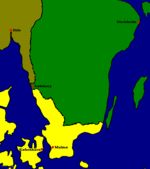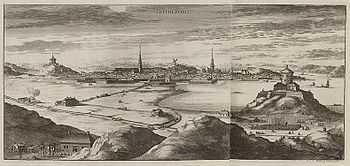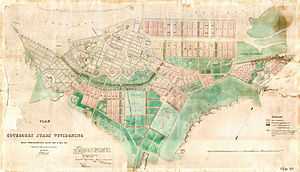History of Gothenburg
The history of Gothenburg begins with the foundation of the heavily fortified town in 1621, during the Thirty Years' War when Sweden was once-again in armed conflict with Denmark-Norway. The location of the new trading port, Sweden's only direct access to the North Sea and Atlantic, was highly strategic: the result of centuries of conflict with the Norwegians just to the north, in Bohuslen, and the Danes, just to the south in Halland.
Prehistory
The region on the west coast of Sweden has been inhabited for several thousands of years. During the Stone Age, there was incidentally a settlement right on present day Gothenburg. As a reminiscence, there are eleven rock carvings in the Gothenburg area.
Predecessors of Gothenburg
Lödöse
The predecessor of present day Gothenburg was Lödöse, 40 kilometers upstream from the present day city on the Göta River, which served as trade centre and port to the west in the Middle Ages. However, Lödöse had problems further down the river – at the Bohus Fortress (present day Kungälv) the Norwegians and the Danes could control the ships to and fro Lödöse and in 1473 the town was moved into a new location called Nya Lödöse (New Lödöse, where the present day suburb Gamlestan in Gothenburg is today). But the new settlement also had its problems and the town dwellers had to seek protection at the old Älvsborg Fortress.
The Gothenburg of Charles IX
King Gustav Vasa tried to build a new city near the old Älvsborg Fortress, but was not successful. When Sweden rose to be a major European power in the 17th century, King Charles IX founded a town on the northern bank of the Göta älv and near the outlet to the sea, on the island Hisingen. This was the first time that the town was named Gothenburg.
This short lived town was almost wholly inhabited by Dutch merchants and immigrants, and Dutch was the official language. The Swedish king attracted the Dutch people to Sweden with the promise of free trade and also free practice of religion (the situation in the Netherlands had become problematic). They enjoyed privileges such as 20 years of tax exemption and lowered customs rates. In return, Sweden and the west coast could benefit of the Dutch skills and trade connections.
The town was granted the right to strike its own gold and silver coins, as well as to have its representatives in the parliament.
However, the island of Hisingen was to a fragile position - they could not withstand the Danes. Soon after the outbreak of the Kalmar War, on 12 June 1611, the town was burned down.[1]
The founding

In 1621 the Swedish king Gustavus Adolphus II decided the location of present day Gothenburg.[2] The settlement used the fortification skills of the Dutch immigrants. Gothenburg was able to grow and prosper within the city walls. Right from this point, the Scots enclave in the city were granted 2 seats on the town council.[3]
The city was heavily influenced by the Dutch. Dutch city planners were contracted to build the city as they had the skills needed to build in the marshy areas around the city. The town was planned after Dutch cities to have canals, like for example Amsterdam, though the blueprint for the canals of Gothenburg are actually the same as those used for Jakarta.[4] The Dutch initially won political power in the city and it was not until 1652, when the last Dutch politician in the city's council died, that the Swedes acquired complete political power over Gothenburg.[5] During the Dutch period the town followed Dutch town laws and there were propositions to make Dutch the official language in the town.
The Gothenburg coat of arms was based on the lion of the coat of arms of Sweden, symbolically holding a shield with the national emblem, the Three Crowns, to defend against its enemies.
In the Treaty of Roskilde (1658) Denmark-Norway ceded the then Danish province Halland, to the south, and the Norwegian province of Bohus County or Bohuslän to the north, leaving Gothenburg in a less exposed position. Gothenburg was able to grow into an important port and trade centre on the west coast thanks to the fact that it was the only city on the west coast that was granted, together with Marstrand, the rights to trade with merchants from other countries.[5]
A growing harbour city

In the 18th century, fishing was the most important industry. However, in 1731 the Swedish East India Company was founded, and the city flourished due to its foreign trade with highly profitable commercial expeditions to Asian countries.
The harbour developed into Sweden's main harbour for trade towards the west and with the Swedish emigration to North America increasing, Gothenburg became Sweden's main point of departure. The impact of Gothenburg as a main port of embarkation for Swedish emigrants is reflected by Gothenburg, Nebraska, a small Swedish settlement in the United States.
Modern Gothenburg


With the 19th century, Gothenburg evolved into a modern industrial city that continued on into the 20th century. The population increased tenfold in the century, from 13,000 (1800) to 130,000 (1900). In the 20th century, major companies that developed included SKF (est. 1907) and Volvo (est. 1926).
In more recent years however, the industrial section has faced a recession, which has spurred the development of new sectors such as increased merchandising, tourism and cultural and educational institutions.
In 2001, major protests occurred in the city during the EU summit and the visit by US President George W Bush.
Notes
- ↑ Eriksson, Folke (1955). Lundby på Hisingen - från istid till nutid. Göteborg: Tre böcker. pp. 39–41. ISBN 91-7029-161-6.
- ↑ According to legend, when the king looked for a suitable location for the new city, suddenly a dove fleeing from an eagle landed at his feet, seeking shelter. Gustavus took that as a sign from God that this would be the location of the city, and uttered the famous words: "Here shall the city lie!" - http://runeberg.org/naturoch/gotaland/0302.html
- ↑ At Home Abroad: Ethnicity and Enclave in the Worrd of Scots Traders in Northern Europe, c.1600-1800* by Douglas Catterall (page 10)
- ↑ http://www.goteborg.com/en/Travel/Articles/Goteborg---Castle-of-the-Goths/
- ↑ 5.0 5.1 Henriksson, Dick and Älveby, Rustan. (1994). Vårt Levebröd - Göteborgregionens näringsliv Igår, I dag och I morgon. Publisher: Akademiförlaget. Page 5. ISBN 91-24-16635-9
Further reading
- William Coxe (1785), "Gotheborg", Travels into Poland, Russia, Sweden and Denmark (2nd ed.), London: Printed for T. Cadell
- "Gotenburg", Norway, Sweden, and Denmark (8th ed.), Leipsic: Karl Baedeker, 1903